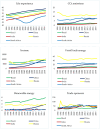Energy choices to health outcomes: A multidimensional analysis of risk in BRICS via PMG-ARDL approach
- PMID: 39689094
- PMCID: PMC11651603
- DOI: 10.1371/journal.pone.0310558
Energy choices to health outcomes: A multidimensional analysis of risk in BRICS via PMG-ARDL approach
Abstract
This article employs a Panel Mean Group Autoregressive Distributed Lag (PMG-ARDL) approach to investigate the interaction between carbon dioxide (CO2) emissions, Gross Domestic Product (GDP), fossil fuel, renewable energy consumption, trade, and their collective impact on life expectancy within the BRICS nations. The research reveals compelling findings. Notably, CO2 emissions and trade openness exhibit negative and statistically significant impact on life expectancy. In contrast, GDP per capita and renewable energy consumption are positive and significant determinants of longer life expectancy. The nuanced outcomes underscore the complex interplay of economic, environmental, and social factors within the BRICS nations. The effects found by PMG-ARDL and FMOLS are very comparable, except for the trade openness' coefficients, which is the inverse. These findings hold significant implications for policy interpretation and sustainable development strategies. As nations struggle to balance economic growth and environmental improvement with public health, tailored interventions targeting CO2 reduction, trade openness, renewable energy, and GDP growth can collectively contribute to longer life expectancy. In a broader context, this research contributes to the global discourse on sustainability, economic improvement, and health issue.
Copyright: © 2024 Kaya et al. This is an open access article distributed under the terms of the Creative Commons Attribution License, which permits unrestricted use, distribution, and reproduction in any medium, provided the original author and source are credited.
Conflict of interest statement
The authors have declared that no competing interests exist
Figures
Similar articles
-
Nexus between energy consumption and carbon dioxide emission: evidence from 10 highest fossil fuel and 10 highest renewable energy-using economies.Environ Sci Pollut Res Int. 2022 Dec;29(58):87901-87922. doi: 10.1007/s11356-022-21900-9. Epub 2022 Jul 12. Environ Sci Pollut Res Int. 2022. PMID: 35821330
-
The effect of carbon dioxide emission and the consumption of electrical energy, fossil fuel energy, and renewable energy, on economic performance: evidence from Pakistan.Environ Sci Pollut Res Int. 2019 Jul;26(21):21760-21773. doi: 10.1007/s11356-019-05550-y. Epub 2019 May 27. Environ Sci Pollut Res Int. 2019. PMID: 31134543
-
Energy consumption and innovation-environmental degradation nexus in BRICS countries: new evidence from NARDL approach using carbon dioxide and nitrous oxide emissions.Environ Sci Pollut Res Int. 2023 Nov;30(53):113561-113586. doi: 10.1007/s11356-023-29927-2. Epub 2023 Oct 18. Environ Sci Pollut Res Int. 2023. PMID: 37851255
-
The 2023 Latin America report of the Lancet Countdown on health and climate change: the imperative for health-centred climate-resilient development.Lancet Reg Health Am. 2024 Apr 23;33:100746. doi: 10.1016/j.lana.2024.100746. eCollection 2024 May. Lancet Reg Health Am. 2024. PMID: 38800647 Free PMC article. Review.
-
Do financial development, financial stability and renewable energy disturb carbon emissions? Evidence from asia-pacific economic cooperation economics.Environ Sci Pollut Res Int. 2023 Jul;30(35):83198-83213. doi: 10.1007/s11356-023-28418-8. Epub 2023 Jun 26. Environ Sci Pollut Res Int. 2023. PMID: 37365366 Review.
References
-
- Cervellati M., & Sunde U. (2011). Life expectancy and economic growth: the role of the demographic transition. Journal of economic growth, 16, 99–133. doi: 10.1007/s10887-011-9065-2 - DOI
-
- Pattak D.C.; Tahrim F.; Salehi M.; Voumik L.C.; Akter S.; Ridwan M.; et al.. The Driving Factors of Italy’s CO2 Emissions Based on the STIRPAT Model: ARDL, FMOLS, DOLS, and CCR Approaches. Energies 2023, 16, 5845. 10.3390/en16155845 - DOI
-
- Zimon G.; Tarighi H.; Salehi M.; Sadowski A. Assessment of Financial Security of SMEs Operating in the Renewable Energy Industry during COVID-19 Pandemic. Energies 2022, 15, 9627. 10.3390/en15249627 - DOI
-
- Hendryx M., & Holland B. (2016). Unintended consequences of the Clean Air Act: Mortality rates in Appalachian coal mining communities. Environmental Science & Policy, 63, 1–6.10.1016/j.envsci.2016.04.021 - DOI
MeSH terms
Substances
LinkOut - more resources
Full Text Sources
Research Materials


